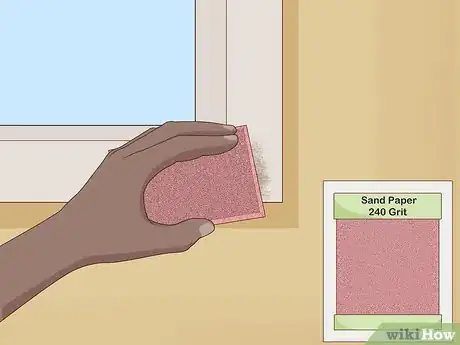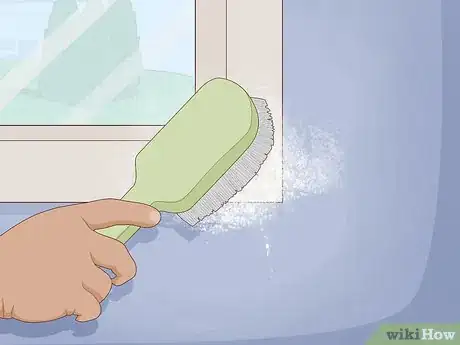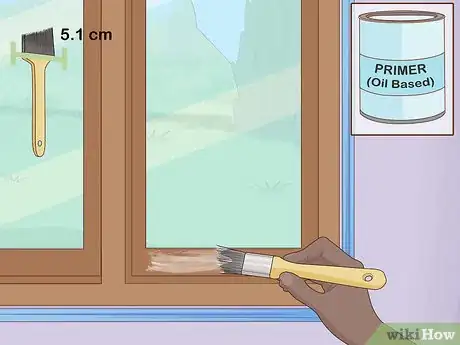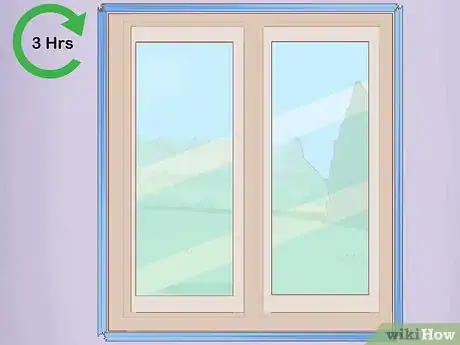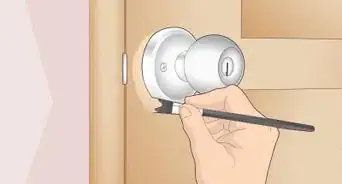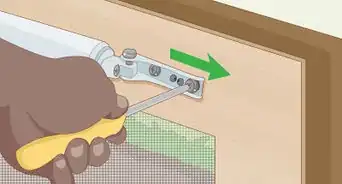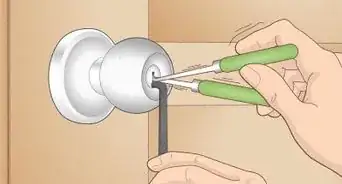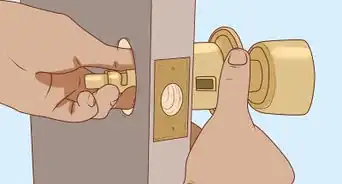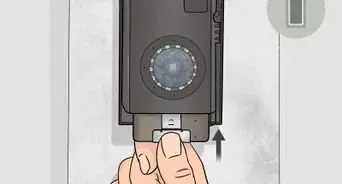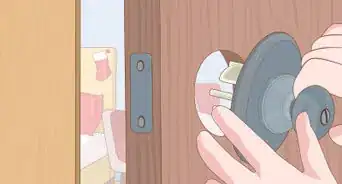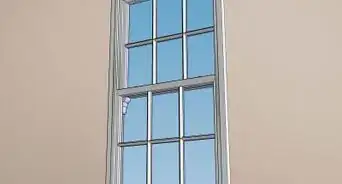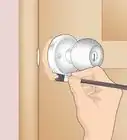This article was co-authored by Jeff Baldwin. Jeff Baldwin is a Residential Painter and the Owner of Baldwin Custom Painting. With two decades of painting experience, Jeff specializes in high-end residential and small commercial painting projects. Dedicated to quality craftsmanship, Jeff and Baldwin Custom Painting provide bonded/insured, licensed, and lead-safe certified services in residential painting, light commercial painting, and wood refinishing.
There are 12 references cited in this article, which can be found at the bottom of the page.
This article has been viewed 72,729 times.
Window frames provide a decorative and protective box around window panes. The frames are usually wooden, and painting them generally requires a great amount of attention to detail. The goal of any paint job on window frames is to make your windows look rejuvenated and fantastic while preventing messy mistakes. With a little bit of time and care, you'll have your window frame looking great in no time!
Steps
Preparing the Frame for Painting
-
1Put down a towel in front of the window. This is simply a precautionary measure to catch the old paint that falls to the ground once you start scraping it off. Having a towel down saves you a lot of time in the future so you don't have to worry about vacuuming or extensive cleanup.[1]
- Use a towel that you don't mind getting dirty or ruined. If you don't have a towel, use any old piece of material.
- You can also keep your drop-cloth in place by sticking tape on the ground by the edge of the wall and pressing the edge of your material into the tape.
- It should be noted here that this process is the same whether your window frame is metal or wood. However, if your frame is metal, stripping the paint is even more important in order to combat rust.[2]
-
2Scrape the old paint off using a scraper or painter's multi-tool. Do this by digging the edge of the tool into the paint and then pushing down and forward into the window frame. Be careful not to scratch the window pane here if you are getting near it.
- When finished, the surface doesn't need to be completely free from all traces of paint, just the majority of it.[3]
- For smaller areas, use a small scraper which will be able to get into the corners and parts a large scraper cannot.
Advertisement -
3Fill in any holes created by nails with regular spackling putty. Spackle is essentially a putty that is used to fill in holes or imperfections. It then hardens and provides a neutral, flat surface to paint over. Apply it by using a scraper and spreading it on sort of like butter.
- Generally speaking, less is more with spackle as you don't want to put so much on that it forms a mound. You can always apply more later.
- You can buy spackle very cheaply from any hardware store.[4]
-
4Sand down the frame and patched areas using 240-grit sandpaper. Sanding the frame down has several benefits. The first of these is that it actually helps the paint stick better when you eventually apply the coat. Secondly, it creates a nice even surface for you to work on so you don't have to worry about finishing painting only to find the frame is bumpy.
- A good technique when sanding is to cup the sandpaper in your palm and gently rub the surface that you are working on. Long, smooth strokes work better than short, quick strokes.[5]
-
5Brush debris off the frame. Once you've scraped and sanded down the surface, it's likely that there are plenty of little bits of debris still clinging on to the frame. Getting rid of these is important to make sure they don't interfere with your new coat of paint. Brush gently around the entire frame with a clean paint brush to get rid of as much debris as possible.
- Be sure to get into the corners as well as plenty of pieces of wood and paint can often clump up here.[6]
Priming and Painting Your Frame
-
1Lay painter's tape down around the outside of the frame. Do this by tracing the outline of the frame with the tape to form a perimeter around it. This ensures that you will get a clear and straight divide between the coat of paint and either the wall or the window pane.[7]
- You should position the tape 0.2 centimetres (0.079 in) from the edge of the frame to ensure the paint covers all of the frame.
- If you don't have painter's tape, masking tape works fine as well. You can get this from any hardware store.[8]
- If you want to avoid painting the hinges of the doorframe, cover these as well.
-
2Apply an oil-based primer using a 2 in (5.1 cm) angle brush. Oil-based primers create a better bond between the paint and the wood. It's okay to use a spray on primer but make sure that you work the spray into the wood using the brush as well
- Apply the primer by using long flowing strokes with the brush on the area you are trying to cover.
- Using an angle brush allows you to have easier access to the corners and other difficult to reach spots.[9]
- You only need to apply primer to surfaces that you scraped and smoothed. If you are simply putting on a new coat of paint, you don't need to worry about primer.
-
3Wait about 3 hours for the primer to dry. The primer needs to be dry for you to be able to paint over the top of it. If it is a particularly humid day, the primer may take a little bit longer than this but 3 hours should be about right.[10]
-
4Apply your oil-based paint using a 2 in (5.1 cm) angle brush. Your frame is ready to be painted! Do your best not to get paint in places it shouldn't be, but it's not the end of the world if you do. There's no need to skimp on the paint here either so be generous. Go for long flowing strokes with your brush to get a smooth, even coat.
- If you are painting a casement window, paint the frame first and finish with the sill. If you are painting a sash window, paint the bottom frame first. Once it is dry to the touch, move the bottom frame up, move the other frame down, and paint the second one.[11]
- Keep your brush nice and loaded with paint throughout this process.
- Feel free to transfer some paint from the large can to a smaller container like a yogurt or sour cream cup. This will make dipping and handling much easier.[12]
-
5Remove the painter's tape. When done correctly, there will be a solid clear line between the edge of the paint and the start of the other surface. Remove it gently at a 45-degree angle so you don't accidentally make any marks on the surface.[13]
- If any paint happens to drip through after you remove the tape, wipe it away immediately with a lightly dampened cloth.
- If you leave the paint to dry and then remove the tape, it can result in peeling.
- If you plan on applying a second coat, don't remove the tape.
-
6Let the paint dry over the course of 24 hours. It takes up to 24 hours for paint to dry so leave the paint alone during this time. Some paints will take less time, but 24 hours is a safe estimate for an oil-based paint.
- If you have a casement window, be careful not to let the paint dry with the window closed as this will make the various parts of the frame stick to each other.
- Once the paint is dry, feel free to apply a second coat of paint if you would prefer a thicker coat.[14]
Expert Q&A
-
QuestionHow do I prepare a window frame for painting?
 Jeff BaldwinJeff Baldwin is a Residential Painter and the Owner of Baldwin Custom Painting. With two decades of painting experience, Jeff specializes in high-end residential and small commercial painting projects. Dedicated to quality craftsmanship, Jeff and Baldwin Custom Painting provide bonded/insured, licensed, and lead-safe certified services in residential painting, light commercial painting, and wood refinishing.
Jeff BaldwinJeff Baldwin is a Residential Painter and the Owner of Baldwin Custom Painting. With two decades of painting experience, Jeff specializes in high-end residential and small commercial painting projects. Dedicated to quality craftsmanship, Jeff and Baldwin Custom Painting provide bonded/insured, licensed, and lead-safe certified services in residential painting, light commercial painting, and wood refinishing.
Residential Painter Tape around the edges of the frame if you want to have a clean, smooth edge.
Tape around the edges of the frame if you want to have a clean, smooth edge. -
QuestionWhat paint is best for window frames?
 Jeff BaldwinJeff Baldwin is a Residential Painter and the Owner of Baldwin Custom Painting. With two decades of painting experience, Jeff specializes in high-end residential and small commercial painting projects. Dedicated to quality craftsmanship, Jeff and Baldwin Custom Painting provide bonded/insured, licensed, and lead-safe certified services in residential painting, light commercial painting, and wood refinishing.
Jeff BaldwinJeff Baldwin is a Residential Painter and the Owner of Baldwin Custom Painting. With two decades of painting experience, Jeff specializes in high-end residential and small commercial painting projects. Dedicated to quality craftsmanship, Jeff and Baldwin Custom Painting provide bonded/insured, licensed, and lead-safe certified services in residential painting, light commercial painting, and wood refinishing.
Residential Painter Look for a paint that's specifically meant for trim since it will brush on easier and last longer.
Look for a paint that's specifically meant for trim since it will brush on easier and last longer.
Warnings
- Always make sure the room you're working in is well ventilated and that you wear a mask when working closely with paint.⧼thumbs_response⧽
Things You'll Need
- Towel or other old material
- Painter's tape
- Oil-based paint primer
- Spackle
- Oil-based paint
- Paintbrush (ideally an angled brush or a sash brush)
- Paint scraper or razor blade
References
- ↑ https://www.todayshomeowner.com/video/keeping-drop-cloths-in-place-when-painting-a-room/
- ↑ https://www.property24.com/articles/how-to-paint-steel-window-frames/14941
- ↑ http://www.housepaintingguide.org/how-to-scrape-paint-that-peels-or-loosens/
- ↑ https://www.apartmenttherapy.com/how-to-paint-a-windowsill-window-trim-apartment-therapy-tutorials-184652
- ↑ https://www.familyhandyman.com/painting/how-to-prepare-wood-trim-for-a-smooth-paint-job/view-all/
- ↑ https://www.bobvila.com/articles/paint-stripping/
- ↑ Jeff Baldwin. Residential Painter. Expert Interview. 26 February 2021
- ↑ https://www.realsimple.com/home-organizing/home-improvement/painting/how-use-painters-tape
- ↑ https://www.thisoldhouse.com/how-to/how-to-cut-paint-edges-brush
- ↑ http://www.familytime.com/showarticle.aspx?articleid=891
- ↑ https://www.diydoctor.org.uk/projects/paintingcasementwindow.htm
- ↑ https://www.apartmenttherapy.com/how-to-paint-a-windowsill-window-trim-apartment-therapy-tutorials-184652
- ↑ https://www.realsimple.com/home-organizing/home-improvement/painting/how-use-painters-tape
- ↑ https://www.bobvila.com/articles/how-long-does-it-take-paint-to-dry/



